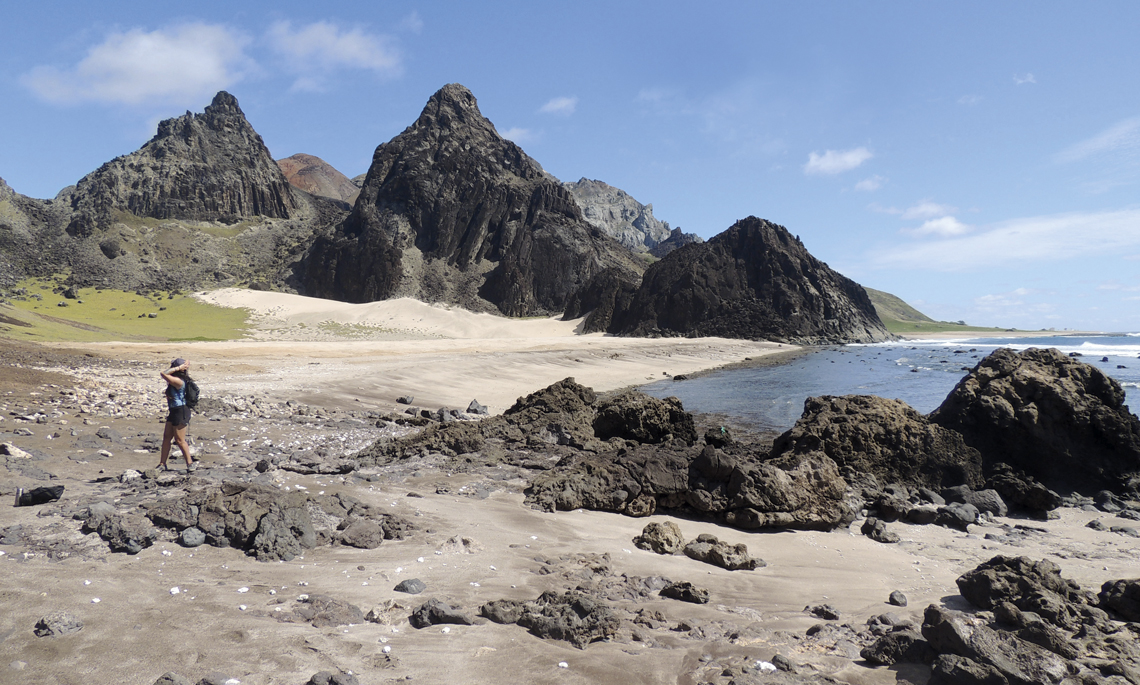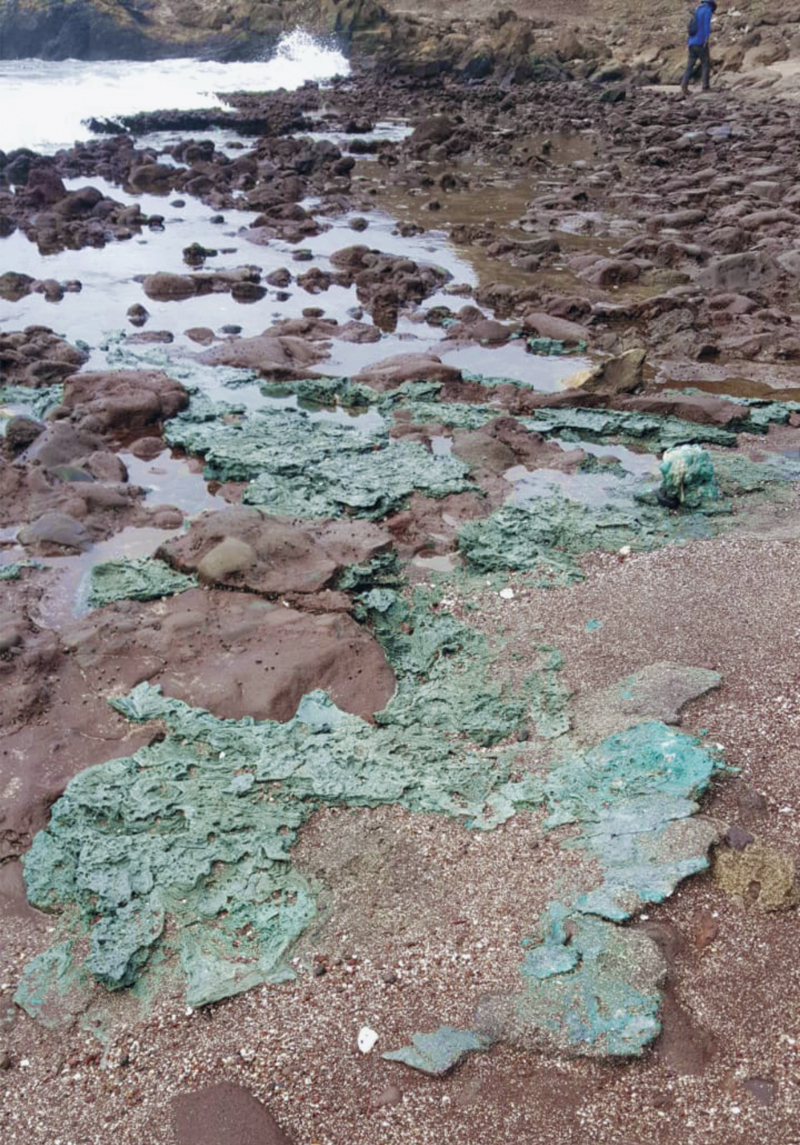In June 2019, while walking along the beaches of the volcanic island of Trindade, 1,140 kilometers (km) from the coast of the state of Espírito Santo, geologist Fernanda Avelar Santos was struck by a greenish glow of rock-like debris spread across the sand. She was confused: the color clashed with the black magmatic rocks and the island’s typical reddish sand.
Back on the mainland, when analyzing the collected samples in a laboratory of the Federal University of Paraná (UFPR), in Curitiba, she, along with her team and colleagues from the University of São Paulo (USP) and the Federal University of Rio Grande do Sul (UFRGS), came to the conclusion that they were hybrid rocks, made of beach sediments, the carapaces of dead animals, and melted plastic, with diameters that varied from 3 centimeters (cm) to 40 cm. The analyses indicated that they are composed of polyethylene and polypropylene, two synthetic polymers used in packaging and fishing lines.
“Plastic waste has become a new geological component of the Earth with potential to affect marine life, even in distant places such as the island of Trindade,” concludes Santos. Administered by the Brazilian Navy and with no fixed resident population, the island and the surrounding waters are home to various species of birds, fish, whales, sharks, and corals. The beaches on which she found what she named plastic rocks, in the Parcel das Tartarugas region, are one of the main nesting sites of green sea turtles (Chelonia mydas) in Brazil.

Pyroplastics from the Caribbean (right) and from Brazil (left)Rangel-Buitrago, N. et al. Marine Pollution Bulletin. 2023. | Fernanda Avelar Santos / UFPR
It is estimated that the plastic materials may have arrived there in recent years via marine currents. It is not known how they could have melted. “They are nothing more than plastic trash that has fused with other materials. In studies done in other countries, this type of material is formed through the burning of plastic in fires,” she observes. “But this doesn’t appear to be the case in Trindade.”
Santos and her colleagues described the rocks they found in an article published in September 2022 in the scientific journal Marine Pollution Bulletin. This material was described for the first time in 2014 on the beach of Kamilo, in Hawaii, known for the accumulation of nets, floats, and plastic packaging, brought by ocean currents. In 2023, six studies reported similar formations on the islands of Heligoland, in the North Sea, in Europe, on Aves Island, in the Caribbean, on beaches on the coasts of Colombia, Indonesia, and Bangladesh, and in a stream in China.
The three types
The plastic debris can be of three types: plastistones, plastiglomerates, and pyroplastics.
Only described by the Brazilian group so far, with few natural elements, plastistones are almost entirely formed of plastic. “They have similar texture and structures to volcanic rocks,” compares Santos.
The plastiglomerates are analogous to sedimentary rocks, formed from mineral or organic materials, such as pieces of rocks and shells, agglomerated and cemented by melted plastic, but in lower quantity. They are generally rough and dense—some samples weigh up to 2 kilograms (kg).
Finally, the pyroplastics can originally be one of the previous two formations, but already entering a state of erosion, with more rounded shapes. “The rocks of this type that were on the beach were mainly eroded by the waves,” observes Santos.
On the island of Trindade, for the first time, combinations of these three types of plastic debris were found in the same outcrop. It is common to find pieces of rocks there with more than one of these types mixed together. “On my last visit to the island, I found more pyroplastics, which suggests that these rocks are already more eroded and possibly releasing microplastics [polymer particles smaller than 5 millimeters],” says the geologist (see Pesquisa FAPESP issue nº 332).
In the article, Santos argues that the term rock should be applied to these findings and that this type of formation would be another marker of the Anthropocene, a new geological era characterized by the impacts of humanity on Earth (See Pesquisa FAPESP issues 243 and 307).
Impacts on marine life
“In the same way as the floating plastic debris, these rocky formations may be reservoirs of viruses, fungi, and bacteria,” says Italian marine biologist Tommaso Giarrizzo, a visiting professor at the Federal University of Ceará (UFC) who did not participate in the study. “Because of the exposure to the sun, wind, tides, and rain, the plastic materials may release chemical compounds, which are potentially toxic to marine organisms.”

Parcel das Tartarugas, on the island of Trindade: the site where the first plastic rocks were foundFernanda Avelar Santos / UFPR
In Trindade, the organisms that live and reproduce in the tidal rock pools could suffer the greatest impacts, in the researcher’s assessment. “The plastic formations have the capacity to drastically alter the habitats of these organisms, compromising their survival and affecting the entire marine food chain,” he warns.
Another study supports this possibility. Published in June in the journal Scientific Reports, the work reports melted plastic ropes, fibers, textiles, packaging, and lids in plastiglomerates and pyroplastics found on a beach on the island of Panjang, in the Java Sea, in Indonesia. The synthetic polymers had high concentrations of polycyclic aromatic hydrocarbons (PAHs), toxic contaminants probably resulting from the open burning of plastic waste.
“These new types of plastic pollution may be a very important vector for the chemical contamination of nearby coastal habitats, such as coral reefs, seagrass meadows, and mangroves,” wrote the researchers from Indonesia and Germany.
Scientific articles
SANTOS, F. A. et al.Plastic debris forms: Rock analogues emerging from marine pollution. Marine Pollution Bulletin. Vol. 182, 114031. Sept. 2022.
UTAMI, D. A. et al. Plastiglomerates from uncontrolled burning of plastic waste on Indonesian beaches contain high contents of organic pollutants. Scientific Reports. Vol. 13, 10383. June 2023.

